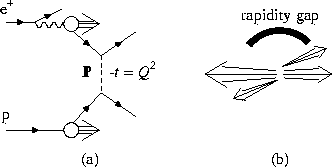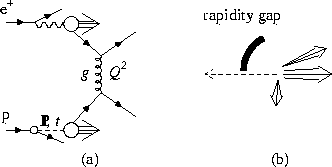


Next: Central Rapidity Gaps
Up: Introduction
Previous: Hard photoproduction
The analyses which will be discussed in this report both make use of the
operational definition of diffraction [4]:
A process is diffractive if and only if there is a large
rapidity gap in the produced-particle phase space which is not
exponentially suppressed.
They are, in addition, studies of hard diffraction in the sense that the
events all possess a large (negative) squared momentum transfer, Q2, or
a high energy scale, Q. The hard diffraction
events are further subdivided into two classes both of which have gone by
a number of different names.
The first class of events may be called
hard diffractive scattering, hard double-dissociation diffraction or
high-t diffraction.
They proceed as shown in Figure 3(a), via the exchange of a
colour singlet object of large negative squared invariant mass, t.
(t, in both event classes,
refers to the square of the momentum transfer across the exchanged colour
singlet
object. This object is called a pomeron and denoted  .)
.)
Figure:
Hard diffractive scattering at HERA. The diagram for this
process is shown
in (a). The exchanged colour singlet object is denoted  and
the negative of its squared invariant mass, -t, sets the energy
scale of the interaction, (
and
the negative of its squared invariant mass, -t, sets the energy
scale of the interaction, ( ).
In the final state, shown in (b),
there are two high transverse energy jets and two remnant jets with
a gap in particle production in the central rapidity region.
).
In the final state, shown in (b),
there are two high transverse energy jets and two remnant jets with
a gap in particle production in the central rapidity region.
 |
Owing to the absence of colour flow across the middle of the event a gap in
the production of particles is expected to be observable.
These events thus contain a central rapidity gap as illustrated in
Figure 3(b).
This may be contrasted with the situation, for example, where a gluon is
exchanged in place of the pomeron in Figure 3(a).
Central rapidity gap events will be examined in Sect. 2.
The second class of events has been called diffractive hard scattering,
hard single-dissociation diffraction and low-t diffraction. These events
are understood to occur when a colour singlet object, travelling collinearly
with the proton, is probed by the hard subprocess. An example is
shown in Figure 4(a).
Figure:
The diffractive hard photoproduction process at HERA is shown in (a).
The pomeron, denoted  , is shown being emitted from the
proton with a squared momentum transfer t. A quark from the
pomeron
subsequently enters the hard
subprocess which is mediated by the exchange of a gluon,
denoted g, and
characterized by the energy scale Q. The
topology of the final state is shown in (b). There are two high
transverse energy jets associated with the hard subprocess. There
may be a photon remnant. However the proton is not broken up and
disappears down the forward beam pipe leaving a gap in particle
production at high rapidities.
, is shown being emitted from the
proton with a squared momentum transfer t. A quark from the
pomeron
subsequently enters the hard
subprocess which is mediated by the exchange of a gluon,
denoted g, and
characterized by the energy scale Q. The
topology of the final state is shown in (b). There are two high
transverse energy jets associated with the hard subprocess. There
may be a photon remnant. However the proton is not broken up and
disappears down the forward beam pipe leaving a gap in particle
production at high rapidities.
 |
Because the object emitted by the proton
does not carry colour, particle production into the forward, or high- ,region of phase space is suppressed. This process thus leads to the
formation of a forward rapidity gap as illustrated in
Figure 4(b). This process is studied in Sect. 3.
,region of phase space is suppressed. This process thus leads to the
formation of a forward rapidity gap as illustrated in
Figure 4(b). This process is studied in Sect. 3.



Next: Central Rapidity Gaps
Up: Introduction
Previous: Hard photoproduction
latex2html conversion by www person on 1997-08-14
![]() .)
.)